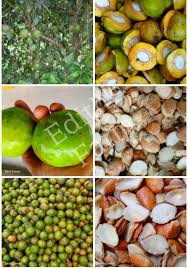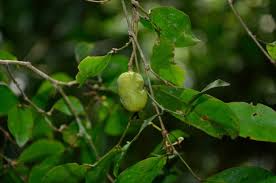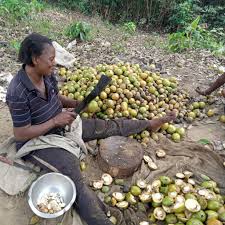Ogbono plant cultivation, also known as Irvingia gabonensis, has gained popularity for its nutritious seeds, which are widely used in various culinary dishes across Africa, particularly in West and Central Africa. This unique plant, often referred to as the wild mango or African mango, thrives in tropical climates and is known for its numerous health benefits, including weight management and cholesterol reduction. Understanding the essential cultivation tips for the Ogbono plant is vital for farmers and enthusiasts looking to tap into its economic potential and contribute to sustainable agricultural practices.
The Ogbono tree is a medium-sized evergreen tree that can grow up to 20 meters tall, with a broad, spreading canopy. It prefers well-drained, loamy soils with good organic content, making soil preparation a crucial step in cultivation. Farmers should select a site with adequate sunlight and shelter from strong winds, as these conditions are essential for healthy growth. Before planting, it’s important to prepare the land by clearing any weeds and debris, tilling the soil, and incorporating organic matter, such as compost or well-rotted manure, to enhance fertility. Proper land preparation ensures that the roots can establish firmly and access the necessary nutrients.
When it comes to planting, Ogbono seeds can be planted directly in the ground or in nursery beds for later transplantation. The seeds should be collected from ripe fruits, cleaned, and dried to prevent fungal infections. The recommended planting distance is about 8 to 10 meters apart to allow for proper growth and airflow. Timing is essential, and planting is best done at the onset of the rainy season when the soil is moist and favorable for germination. Regular watering is important, especially during dry spells, as the Ogbono plant requires adequate moisture for optimal growth.
Fertilization plays a significant role in the healthy growth of the Ogbono plant. Organic fertilizers, such as poultry manure, can be applied during the growing season to provide essential nutrients. In addition to fertilizers, mulching around the base of the plants can help retain soil moisture and suppress weeds, reducing competition for nutrients. Implementing these practices can enhance the overall health and yield of the Ogbono plant.
Pest and disease management is also critical in Ogbono cultivation. Common pests include caterpillars and leaf-cutting ants, which can damage the leaves and impede growth. Integrated pest management practices, such as introducing natural predators and using organic pesticides, can effectively control these threats while minimizing harm to the environment. Regular monitoring of the plants for signs of disease and pest infestations is essential to ensure timely intervention.
Harvesting Ogbono fruits occurs once they reach maturity, typically about 4 to 5 months after flowering. The fruits should be harvested carefully to avoid damaging the branches and to ensure the seeds remain intact for further cultivation. After harvesting, the seeds should be extracted, cleaned, and dried properly for storage or immediate planting.
Importance of Ogbono in Agriculture
1. Economic Value: Ogbono, derived from the seeds of the wild mango (Irvingia gabonensis), has significant economic importance, especially in West African countries. The seeds are highly valued for their nutritional content and are used in various culinary dishes, contributing to local and international markets. This trade boosts the livelihoods of farmers and helps support rural economies.
2. Nutritional Benefits: Ogbono seeds are rich in nutrients, including proteins, healthy fats, vitamins, and minerals. Their nutritional profile makes them an important food source for many communities, contributing to food security and improving the overall health of populations that rely on them. The seeds are also used in traditional medicine, enhancing their value beyond just culinary use.
3. Agroforestry Potential: Ogbono trees can be integrated into agroforestry systems, promoting biodiversity and sustainability. By planting Ogbono alongside other crops, farmers can improve soil health, enhance microclimates, and create habitats for wildlife. This practice can lead to better yields and more resilient farming systems.
4. Crop Diversification: Including Ogbono in farming systems allows for greater crop diversification. This diversification can reduce the risk of crop failure due to pests, diseases, or market fluctuations. It enables farmers to adapt to changing environmental conditions and market demands while ensuring a steady income.
5. Soil Improvement: The cultivation of Ogbono can contribute to soil improvement. The deep roots of Ogbono trees help prevent soil erosion, enhance soil structure, and increase organic matter content through leaf litter decomposition. Healthier soils lead to better crop productivity and sustainability.
Read Also: List of “23” Healing Herbs in the Bible
Selecting the Right Variety of Ogbono

1. Local Adaptation: When selecting Ogbono varieties, it’s essential to choose those that are well-adapted to local conditions, including climate, soil type, and rainfall patterns. Local varieties are often more resilient to pests and diseases and may perform better in specific environmental conditions.
2. Yield Potential: Farmers should consider the yield potential of different Ogbono varieties. High-yielding varieties can significantly impact income and food security. Researching and selecting varieties that have been proven to produce higher quantities of seeds can enhance profitability.
3. Nutritional Quality: The nutritional quality of Ogbono seeds can vary between varieties. Selecting varieties with higher protein, fat, and micronutrient content can add value to the harvest and improve the nutritional benefits for consumers. Farmers should also consider the culinary qualities of the seeds, such as flavor and texture.
4. Pest and Disease Resistance: Choose varieties that demonstrate resistance to common pests and diseases affecting Ogbono crops. This can help reduce reliance on chemical pesticides and lower production costs while promoting sustainable farming practices. Consulting agricultural extension services or local agricultural research institutions can provide valuable insights into resistant varieties.
5. Growth Habit: Consider the growth habit of the Ogbono tree when selecting a variety. Some varieties may be more suitable for certain farming systems, whether intercropped with other plants or grown as a monoculture. The growth habit can also influence management practices, including spacing and pruning requirements.
Ideal Soil Conditions for Ogbono Cultivation
1. Soil Type: Ogbono thrives in well-drained soils, preferably sandy loam to loamy soils. These soil types offer good drainage while retaining adequate moisture for the tree’s growth. Heavy clay soils can impede root development and increase the risk of root rot.
2. Soil pH: The ideal soil pH for Ogbono cultivation ranges from 5.5 to 7.0. Soil within this pH range allows for optimal nutrient availability and uptake. Farmers should conduct soil tests to determine the pH level and amend the soil as necessary to achieve the ideal conditions.
3. Organic Matter Content: High organic matter content in the soil is beneficial for Ogbono cultivation. Organic matter improves soil structure, enhances moisture retention, and provides essential nutrients for plant growth. Incorporating organic amendments like compost or well-rotted manure can boost soil fertility and support healthy Ogbono trees.
4. Moisture Availability: While Ogbono trees are somewhat drought-resistant, consistent moisture is crucial during the establishment phase and early growth. Ensure the soil has adequate moisture levels, especially during the dry season, to support healthy root development and overall growth. Mulching around the base of the trees can help retain soil moisture and suppress weeds.
5. Drainage and Aeration: Good drainage and aeration are vital for Ogbono cultivation. Poor drainage can lead to waterlogging, which negatively impacts root health and may result in disease. Farmers should consider planting Ogbono in raised beds or mounds if drainage issues are present in their fields.
Read Also: 12 Medicinal Health Benefits of Emilia Sonchifolia (lilac tasselflower)
Best Practices for Planting Ogbono Seeds

1. Seed Selection: Choose high-quality seeds from reputable sources to ensure good germination rates and healthy plants. Look for seeds that are plump, free from mold, and exhibit a uniform color. Consider using seeds from local varieties that are well adapted to the region.
2. Pre-Soaking Seeds: Soaking Ogbono seeds in water for 24-48 hours before planting can enhance germination rates. This process helps to soften the seed coat, allowing moisture to penetrate and promoting faster sprouting.
3. Soil Preparation: Prepare the planting site by clearing weeds, debris, and any previous crop residues. Loosen the soil to a depth of about 15-20 cm to improve drainage and aeration. Incorporating organic matter, such as compost, can enhance soil fertility and structure.
4. Planting Depth and Spacing: Plant Ogbono seeds at a depth of about 2-3 cm to protect them from drying out and ensure they have adequate moisture. Space seeds approximately 2-3 meters apart to allow for the trees’ growth and to minimize competition for nutrients and light.
5. Timing of Planting: Plant Ogbono seeds during the rainy season to take advantage of natural rainfall, ensuring consistent moisture for germination. In regions with a defined wet season, timing planting to coincide with these rains can improve establishment success.
Watering and Irrigation Techniques
1. Initial Watering: After planting, water the seeds thoroughly to settle the soil around them and provide sufficient moisture for germination. Ensure the soil remains moist but not waterlogged during the germination period, which typically lasts 2-3 weeks.
2. Drip Irrigation: Implementing a drip irrigation system is highly effective for Ogbono cultivation, as it delivers water directly to the root zone, minimizing evaporation and runoff. This method ensures consistent moisture while conserving water resources.
3. Mulching: Apply a layer of organic mulch around the base of the plants to retain soil moisture, suppress weeds, and regulate soil temperature. Materials such as straw, dried leaves, or wood chips work well for this purpose.
4. Monitoring Soil Moisture: Regularly check soil moisture levels to prevent over or under-watering. Using a soil moisture meter can help determine when to irrigate. Generally, Ogbono trees prefer moist but well-drained conditions.
5. Seasonal Adjustments: Adjust watering frequency according to seasonal rainfall patterns. During the dry season, increase irrigation to maintain adequate moisture levels, while reducing watering during the rainy season when natural precipitation is sufficient.
Fertilization Methods for Optimal Growth
1. Soil Testing: Conduct soil tests to determine nutrient levels and deficiencies. This analysis will guide the selection of fertilizers and amendments needed to support healthy Ogbono growth.
2. Organic Fertilizers: Use organic fertilizers such as well-rotted manure, compost, or vermicompost to improve soil fertility and structure. These materials provide essential nutrients and enhance microbial activity in the soil.
3. Chemical Fertilizers: If necessary, apply chemical fertilizers based on soil test results. A balanced fertilizer with an N-P-K ratio (Nitrogen-Phosphorus-Potassium) appropriate for tree growth (e.g., 10-10-10) can be beneficial during the early growth stages.
4. Fertilizer Application Timing: Fertilize Ogbono trees during the growing season, preferably before the onset of the rainy season, to maximize nutrient uptake. Additional applications may be needed during flowering and fruiting stages to support development.
5. Foliar Feeding: Consider foliar feeding with liquid fertilizers to address specific nutrient deficiencies observed in leaf color or growth. This method allows for rapid absorption of nutrients through the leaves.
Pest and Disease Management in Ogbono Farming
1. Regular Monitoring: Conduct regular inspections of Ogbono trees for signs of pest infestations or diseases. Early detection is crucial for effective management and can prevent more significant losses.
2. Cultural Practices: Implement cultural practices such as proper spacing and pruning to improve air circulation and reduce humidity around the trees. This practice minimizes the risk of fungal diseases and pest proliferation.
3. Biological Control: Utilize natural predators and beneficial insects to manage pest populations. For example, ladybugs and lacewings can help control aphid populations without harming the Ogbono trees.
4. Organic Pesticides: If necessary, use organic pesticides derived from natural sources, such as neem oil or insecticidal soap, to manage pests. These options are less harmful to beneficial insects and the environment.
5. Crop Rotation: Rotate Ogbono with other crops to disrupt pest life cycles and reduce soil-borne diseases. This practice can help maintain soil health and enhance overall farm biodiversity.
Harvesting Techniques for Ogbono

1. Timing the Harvest: Ogbono seeds are typically harvested when the pods have dried on the tree and turned brown, indicating that they are ripe. Harvesting should occur during the dry season to ensure the seeds are fully mature and have optimal oil content.
2. Tools for Harvesting: Use sharp tools like machetes or pruning shears to cut the pods from the tree without damaging the branches. This helps maintain the health of the tree and encourages future growth.
3. Collecting Seeds: After harvesting, open the pods carefully to extract the seeds. It’s advisable to wear gloves, as the sap from the pods can be sticky and may cause irritation. Collect the seeds in clean, dry containers to prevent moisture buildup.
4. Seed Quality Check: Examine the harvested seeds for quality. Good seeds should be plump, free from blemishes or mold, and have a uniform color. Discard any seeds that appear damaged or diseased to ensure high-quality planting stock.
5. Optimal Harvesting Time: The best time to harvest is early in the morning or late afternoon when temperatures are cooler, minimizing moisture loss and damage to the seeds during handling.
Post-Harvest Handling of Ogbono
1. Cleaning the Seeds: After extracting the seeds, wash them gently in clean water to remove any remaining pulp or debris. This process prevents mold growth during storage and ensures better seed quality.
2. Drying the Seeds: Spread the cleaned seeds out in a single layer on a clean, dry surface under shade to air dry. This step is crucial to reduce moisture content to around 8-10%, which helps prevent spoilage during storage.
3. Storage Conditions: Store dried seeds in airtight containers, such as glass jars or vacuum-sealed bags, to protect them from moisture and pests. Keep the containers in a cool, dark place, away from direct sunlight, to maintain seed viability.
4. Seed Viability Testing: Before planting, conduct a viability test by soaking a sample of seeds in water. Viable seeds will sink, while non-viable seeds will float. This test helps ensure that only healthy seeds are planted for the next growing season.
5. Record Keeping: Maintain records of harvest quantities, seed quality, and any issues encountered during the harvesting process. This information is valuable for improving future harvests and understanding yield patterns.
Economic Benefits of Ogbono Cultivation
1. High Market Demand: Ogbono seeds are in high demand due to their nutritional and medicinal properties. They are used in various culinary applications, especially in African cuisines, providing farmers with a lucrative market opportunity.
2. Value-Added Products: Beyond selling raw seeds, farmers can produce value-added products such as Ogbono powder or extracts. These products can fetch higher prices in both local and international markets, increasing profitability.
3. Employment Opportunities: Cultivating Ogbono creates employment for local communities, from planting to harvesting and processing. This can help improve the livelihoods of many families and reduce rural poverty.
4. Crop Diversification: Incorporating Ogbono into agricultural practices promotes crop diversification. This strategy helps reduce the risks associated with monoculture and can lead to improved soil health and reduced pest problems.
5. Soil Improvement: Ogbono trees contribute to soil fertility through leaf litter and root biomass, enhancing the overall productivity of the land. Healthier soils lead to better yields not only for Ogbono but also for other crops in the rotation.
Do you have any questions, suggestions, or contributions? If so, please feel free to use the comment box below to share your thoughts. We also encourage you to kindly share this information with others who might benefit from it. Since we can’t reach everyone at once, we truly appreciate your help in spreading the word. Thank you so much for your support and for sharing!
Read Also: The Roles in the Buying Process and Strategies

